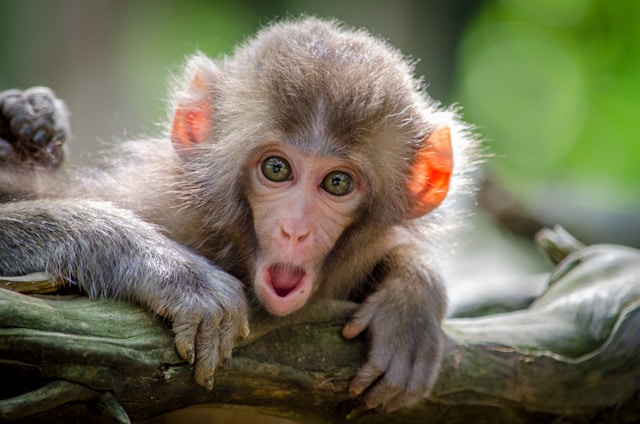In the lush jungles of Belize, amidst the verdant canopies, a remarkable acrobat takes center stage: the Spider Monkey. With their long limbs and astonishingly agile movements, these primates navigate the treetops with unmatched grace. Their prehensile tails, like an extra limb, grant them unparalleled dexterity as they swing effortlessly from branch to branch. Join us on a journey to explore the world of Spider Monkeys in Belize, uncovering their mastery of tree swinging, the power of their prehensile tails, and the intriguing dynamics of their treetop communities.
Tree Swinging Masters: Spider Monkey Canopy Navigation
Spider monkeys in Belize are true masters of the art of tree swinging. Their long limbs, specially adapted for life in the trees, allow them to effortlessly navigate the dense canopy of the jungle. With arms that can span over four feet in length, these primates swing from branch to branch with remarkable agility and precision.
What sets spider monkeys apart is their unique swinging technique. Unlike other monkeys that rely on brachiation (swinging using their arms), spider monkeys use a combination of arm-swinging and their prehensile tails to propel themselves through the treetops. This method allows them to cover long distances quickly while conserving energy—a crucial skill for survival in their dynamic jungle environment.
Observing spider monkeys in action is a spectacle of grace and athleticism. They effortlessly leap from one branch to another, using their strong arms to grab onto branches and their prehensile tails to maintain balance and direction. This acrobatic prowess is not just for show; it’s a vital part of their daily lives as they forage for food, evade predators, and navigate their complex social structures.
Their ability to swing through the trees with such finesse also plays a role in their communication and social interactions. Spider monkeys use vocalizations, facial expressions, and body language to communicate within their groups, but their mobility in the canopy adds another dimension to their social dynamics. It allows them to quickly join or leave subgroups, access different parts of their territory, and engage in playful behaviors that strengthen social bonds.
As we delve deeper into the world of spider monkeys in Belize, we uncover not just their physical prowess but also the intricate ways in which their canopy navigation shapes their lives and interactions in the jungle.
Prehensile Tail Power: Spider Monkeys’ Survival Tool
One of the most fascinating adaptations of spider monkeys in Belize is their prehensile tail—a unique appendage that plays a crucial role in their survival and daily activities. Unlike the tails of many other primates, which are primarily used for balance, spider monkeys’ prehensile tails are highly specialized for grasping and manipulation, almost like an extra hand.
This remarkable tail is not just a passive appendage; it’s a powerful tool that enhances the spider monkeys’ agility and versatility in the treetops. The tail is covered in sensitive skin and has a strong grip, allowing spider monkeys to grasp onto branches with incredible strength and precision. This capability is especially important when navigating thin or fragile branches that may not support their body weight alone.
One of the key advantages of the prehensile tail is its ability to act as a fifth limb, freeing up the spider monkey’s hands for other tasks such as foraging for food or grooming. This efficiency in movement and multitasking is essential in their dynamic jungle environment, where opportunities for food and resources can be fleeting.
The prehensile tail also serves as a tool for communication and social bonding within spider monkey communities. They use their tails to express emotions, such as excitement, frustration, or affection, by wrapping them around each other or using them in playful gestures during social interactions. This non-verbal communication adds depth to their social dynamics and helps strengthen bonds within their groups.
Overall, the prehensile tail is not just a physical feature but a remarkable adaptation that underscores the spider monkeys’ survival strategies. It’s a testament to nature’s ingenuity and the intricate ways in which organisms evolve to thrive in their unique habitats.
Treetop Societies: Spider Monkey Communities in Belize
Spider monkeys in Belize live in complex and dynamic social groups, known as troops, that play a crucial role in their survival and well-being. These treetop societies are characterized by intricate social structures, communication patterns, and cooperative behaviors that contribute to the resilience of the troop as a whole.
Within a spider monkey troop, there is a hierarchical structure based on age, experience, and social relationships. Older, more experienced individuals often hold leadership positions and play a central role in decision-making, troop movements, and conflict resolution. Younger monkeys learn from their elders and gradually assume more responsibilities as they mature.
Communication is a vital aspect of spider monkey societies, and they employ a variety of vocalizations, facial expressions, and body language to convey messages and maintain cohesion within the troop. Alarm calls, for example, alert members to potential threats such as predators, while grooming sessions strengthen social bonds and reinforce alliances.
Cooperation is another hallmark of spider monkey communities. They engage in cooperative activities such as foraging for food, defending territories, and caring for offspring. This collective effort ensures the survival of the entire troop, as individuals work together to overcome challenges and capitalize on opportunities in their environment.
Social dynamics within spider monkey troops are also influenced by factors such as mating behaviors, territoriality, and inter-group interactions. Mating rituals often involve elaborate displays and competition among males for access to females, while territorial boundaries are defended through vocalizations and occasional confrontations with neighboring troops.
Interactions between spider monkey troops can range from peaceful coexistence to territorial disputes, with communication playing a key role in signaling intentions and avoiding conflicts whenever possible. These complex social dynamics highlight the adaptability and resilience of spider monkeys in Belize, showcasing their ability to thrive in the ever-changing jungle environment.
Final Thoughts: Embracing the Complexity of Spider Monkey Life in Belize
The world of spider monkeys in Belize is a tapestry of complexity, woven with threads of adaptation, cooperation, and social intricacies. As we delve deeper into their lives, we uncover not just remarkable physical abilities but also the depth of their social bonds and the resilience of their communities.
The mastery of tree swinging and the power of their prehensile tails are testaments to the evolutionary journey that has shaped spider monkeys into agile and versatile inhabitants of the jungle. Their ability to navigate the canopy with such grace speaks to their intimate connection with their environment and their finely tuned survival strategies.
Beyond individual prowess, spider monkey societies shine as examples of collaborative effort and communication. Troops function as cohesive units, where each member plays a vital role in the collective well-being. From alarm calls that warn of danger to grooming sessions that foster social bonds, every interaction contributes to the fabric of their community.
The dynamics of spider monkey life also reflect the ever-changing landscape of the jungle. Mating rituals, territorial boundaries, and interactions with neighboring troops highlight the adaptive nature of these primates, as they navigate challenges and seize opportunities in their quest for survival.
As we conclude our exploration of spider monkeys in Belize, we are reminded of the interconnectedness of all life forms in the natural world. Their story is not just one of acrobatic feats and biological marvels but a narrative of resilience, cooperation, and adaptation—a narrative that continues to unfold in the intricate tapestry of the jungle.




